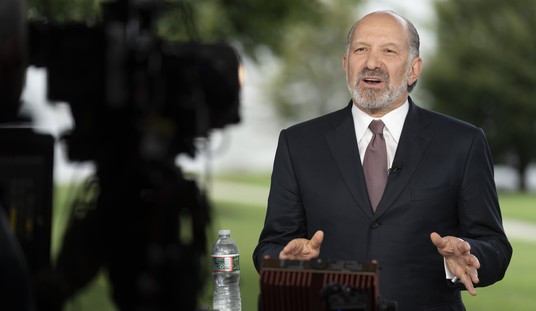As President Barack Obama is touring the country touting his so-called jobs bill, he’s not talking about one of the largest job killers facing American industry — regulation. PJMedia is working with AmericanJobCreators to bring you stories of how over-regulation is destroying jobs nationwide.
One of the most regulated industries in the United States is over-the-road trucking. Nearly anything you have in your house, from light bulbs, to toilet paper, to your flat-screen television, was delivered to where you bought it by truck – indeed, 70 percent of all goods travel by truck. And every year, more regulations are piled on top of one of the key industries for the American economy.
Wayne Meyer drives a refrigerated truck, delivering 640-pound blocks of cheese, and he has been driving for 42 years:
When I first started driving we had log books, but they weren’t enforced. Then they got into control of speed, but I was over in California and California has always been nasty about trucks and speed anyway.
I talked to Meyer in the service department of a Petro Truck Stop in Joplin, Missouri, while he was checking the price on some new tires. He told me that regulations are keeping new drivers off the roads — and if fewer big rigs on the road sounds like a good thing to you as a private driver, keep in mind there already are far fewer truck drivers than are currently needed to sustain the volume of goods being transported. Said Meyer:
We’re around 200,000 drivers short, and they’re making it to where you’ve got to be a jail house lawyer to get down the road. It’s turning a lot of guys off from being a driver.
In a “dispatch from the road” from AJC, Western HiWays Trucking Safety Director Doug Grove said he recently spent two weeks dealing with a paperwork foul-up between different regulatory agencies:
This is where it’s really messed up because it had to go to Washington to get straightened out. … That was a hectic two weeks.
The extra paperwork and nearly $10,500-per-employee compliance costs are far from the only regulatory hurdles Western HiWays and other companies have to overcome in order to compete. Regulations which are often written by people with no idea of the realities of the road — not one sitting congressman has ever been an OTR truck driver — are often impractical at best. At worst, they are impossible to follow. From the AJC dispatch:
The Department of Transportation’s Hours of Service regulation, written to prevent accidents caused by driver fatigue, is one example. The rule says CMV drivers may only work 14 hours a day — 11 actually driving — and the driver must keep a logbook of the total hours spent driving and resting. It sounds sensible, but the regulation doesn’t account for the reality of the road.
You got drivers going into these places to load, and sat eight to ten hours. That’s on the clock,” said Mr. Grove. “If they sit there eight hours, they can only drive three hours. If we didn’t get our mileage in, it don’t matter. Once your 14 hours are up, it’s up.”
Meyer also complained about the hours-of-service regulations, noting his truck is his only transportation. He’s based in Salt Lake City, Utah, but he lives in Northern Arizona — a bit over 12 hours away. But according to the regulations, even after he’s dropped his trailer and is heading for home he can’t legally drive all the way home without stopping to rest — something any private citizen in a car can do without question:
I can’t drive down there legally, to go by those rules. You can run out of time on your log book 10 minutes from town, and you’re not legal to drive on home.
In the dispatch, AJC noted something similar:
An unintended consequence of the well-intentioned Hours of Service rule is that drivers actually may be more fatigued on the road during the day.
“With the logging system, you can’t go in in the afternoon and take a nap without it counting against your time,” Grove said. “Before they changed this, you could stop and break your hours up. You could take a nap.”
Part of the change comes from special interest lawsuits, and not from listening to actual truck drivers. For example, as a result of a 2009 Big Labor-backed sue-and-settle agreement, the Obama Department of Transportation may make the Hours of Service rule even less reality-based.
Meanwhile, job creators like Western HiWays hang in the balance. Grove said the problem is that no one in Washington really understands the problems of the industry:
“I think — and it’s not just in trucking, it’s in anything,” said Mr. Grove. “Anybody can read a book. You can go to college and still be an idiot. … [Washington] needs to get out and, and get in the trucks and experience what actually all happens. I don’t think they’ve taken the time to come out here and see what it’s really like,” he added, slowly shaking his head.
Meyer agreed:
If it’s not broke, don’t fix it. We have a better safety record than any public utility and fire departments and police departments. The politicians have never done anything that remotely resembles common sense, they always go off the deep end: “If a little bit of regulation of this is good then a whole lot oughta be better” — but that’s not necessarily so.
AJC noted the Obama administration has 4,225 new federal regulations in the pipeline, 219 of which carry an annual cost of $100 million or more. All of which will fall most heavily on the small businesses least equipped to handle them – and, just as damaging, on consumers. Businesses are forced to pass on compliance costs, and they generally add a small “fudge factor” to make sure they’ve covered all costs.
Which means the 70 percent of goods which travel by truck cost more every time Washington tacks on a regulation.









Join the conversation as a VIP Member